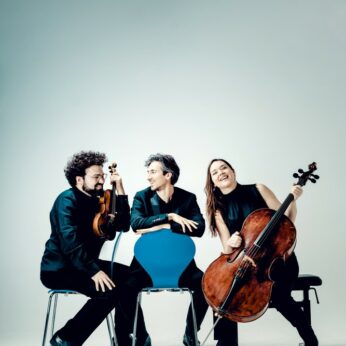Composer: Joseph Haydn (b. 1732 - d. 1809)
Performance date: 28/06/2023
Venue: Bantry House
Composition Year: 1797
Duration: 00:10:10
Recording Engineer: Tom Norton, RTÉ
Instrumentation: vn, va, vc
Instrumentation Category:Piano Trio
Artists:
Trio Gaspard (Jonian Kadesha [violin], Vashti Hunter [cello], Nicholas Rimmer [piano]) -
[Piano Trio]

Piano Trio No.12 in E flat major Hob XV.36 [1797]
Allegro moderato
Polonese
Finale: Allegro molto
I was cut off from the world, there was no one around to mislead and harass me, so I was forced to become original.
–Joseph Haydn
Haydn has a particular and recognisably humorous and playful style and his chamber music has a lightness and joy to it that is pure delight for the listener. The piano trio form was popular in private circles, but the trio of musicians need a great deal of sensitivity and musical awareness to correctly balance the relationship between the three instruments. Haydn spent most of his professional career working for the powerful Esterházy family, his patron was a keen musician and there were almost daily chamber music sessions at his palace. This in part, helps explain Haydn’s prolific output. But perhaps also it explains the great charm that he brought to his compositions, they were written for enjoyment and entertainment, to please his patron and those around him, and one would hope, please himself as well. And although by the time of this composition, Haydn was living in Vienna, he seems never to have lost his good humour. Listening to Haydn’s music, it’s impossible not to feel that here was a man who spent his whole life doing what he loved most.
The first movement has typical Haydenesque playfulness, with delightful Classical ornamentation. Highly rhythmic, with a repeated note jump off in the phrases that pushes the music forward, creating complementary contrast to the delicate and precise ornamentation, particularly in the piano part.
The second movement is much more dramatic with a stately mood, moving between registers. The low register sections are gripping and adventurous, the opening theme, which is repeated throughout is captivating. Haydn creates a dialogue between the high and low register phrases, yet even the darker sounding lower passages retain a mischievous quality that is entirely in keeping with Haydn’s playful humour. This juxtaposition between jollity and seriousness, mysterious and straightforward, is found in many of Haydn’s later quartets and symphonies.
The Finale opening section contains a myriad of running passages – a breath of fresh air, perfect for a summer afternoon. The middle section is entirely contrasting with long sweeping notes in the strings, while the piano fires away with rapid fingering in a counter melody. The contrast between the instruments here creates an intriguing section of music before the return of the opening themes that gain intensity as they move to the final flourish.
Helen Dawson
Copyright © 2025 West Cork Music. All rights reserved.
Designed and developed by Matrix Internet